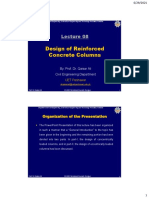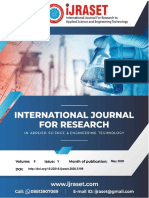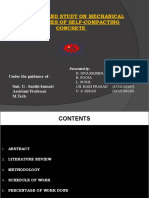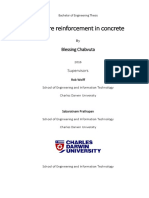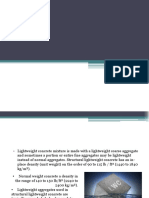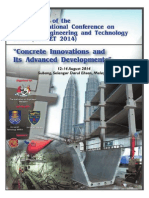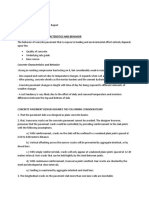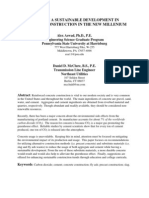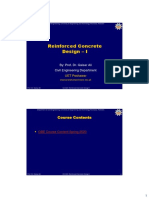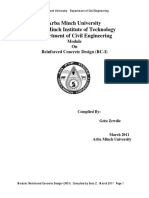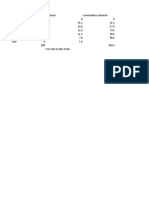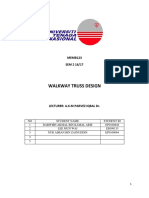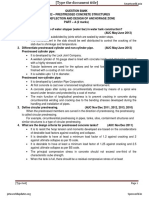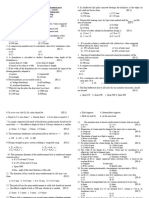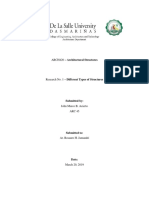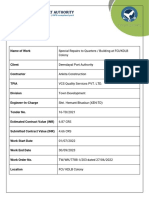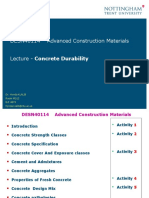Department of Civil Engineering, University of Engineering and Technology Peshawar, Pakistan
Reinforced Concrete Design – I
(CE 320)
By: Prof Dr. Qaisar Ali
Civil Engineering Department
UET Peshawar
drqaisarali@uetpeshawar.edu.pk
Prof. Dr. Qaisar Ali CE 320 Reinforced Concrete Design-I
Department of Civil Engineering, University of Engineering and Technology Peshawar, Pakistan
Course Contents
Mid Term Course
Lecture
Topic
No.
1 Introduction to Reinforced Concrete Design
2 Design of Singly Reinforced Beam for Flexure
3 Design of Doubly Reinforced Beam for Flexure
4 Design of T-Beam and L-Beam Section for Flexure (Single and Two Span
Beam)
5 Design and Detailing for Bond, Anchorage, Development Length, Laps and
Splices
Prof. Dr. Qaisar Ali CE 320 Reinforced Concrete Design-I 2
1
� Department of Civil Engineering, University of Engineering and Technology Peshawar, Pakistan
Course Contents
Final Term Course
Lecture
Topic
No.
6 Design of Reinforced Beam for Shear
7 Design of Reinforced Concrete Slabs
8 Design of Reinforced Concrete Column.
9 Design of Isolated Column Footing
10 Serviceability Criteria of the ACI Code for Deflection and Crack Width
Prof. Dr. Qaisar Ali CE 320 Reinforced Concrete Design-I 3
Department of Civil Engineering, University of Engineering and Technology Peshawar, Pakistan
Grading Policy
Midterm = 25 %
Final Term = 50 %
Session Performance = 25 %
Assignments = 10 % (4 Assignments)
Quizzes = 15 % (4 Quizzes)
Prof. Dr. Qaisar Ali CE 320 Reinforced Concrete Design-I 4
2
� Department of Civil Engineering, University of Engineering and Technology Peshawar, Pakistan
Lectures Availability
All lectures and related material will be available on
the website:
www.drqaisarali.com
Prof. Dr. Qaisar Ali CE 320 Reinforced Concrete Design-I 5
Department of Civil Engineering, University of Engineering and Technology Peshawar, Pakistan
Lecture 01
Introduction to Reinforced
Concrete Design
By: Prof Dr. Qaisar Ali
Civil Engineering Department
UET Peshawar
drqaisarali@uetpeshawar.edu.pk
Prof. Dr. Qaisar Ali CE 320 Reinforced Concrete Design-I
3
� Department of Civil Engineering, University of Engineering and Technology Peshawar, Pakistan
Topics Addressed
General
Properties of concrete
Properties of steel
Codes and the ACI Code
Mechanics of Reinforced Concrete
Prof. Dr. Qaisar Ali CE 320 Reinforced Concrete Design-I 7
Department of Civil Engineering, University of Engineering and Technology Peshawar, Pakistan
General
Objective of the Course
Humans need construction of civil structures such as
buildings, bridges and dams etc. to fulfill their various needs.
An Engineering design would ensure that these structures
are built safe and economical.
Prof. Dr. Qaisar Ali CE 320 Reinforced Concrete Design-I 8
4
� Department of Civil Engineering, University of Engineering and Technology Peshawar, Pakistan
General
Objective of the Course
Materials such as stones, bricks, timber, steel and concrete
are generally used to construct these structures.
In this course, however we will study some basic concepts of
the design of Buildings (bridges, dams etc. will not be
discussed) made of reinforced concrete.
Prof. Dr. Qaisar Ali CE 320 Reinforced Concrete Design-I 9
Department of Civil Engineering, University of Engineering and Technology Peshawar, Pakistan
General
Reinforced Concrete
The concrete in which steel is used as reinforcement for
enhancing primarily the tensile strength of concrete
members.
Prof. Dr. Qaisar Ali CE 320 Reinforced Concrete Design-I 10
5
� Department of Civil Engineering, University of Engineering and Technology Peshawar, Pakistan
General
Buildings
Most common building types
according to how the loads are
transmitted to the ground
Frame System
Load bearing wall system
Mixed System
Prof. Dr. Qaisar Ali CE 320 Reinforced Concrete Design-I 11
Department of Civil Engineering, University of Engineering and Technology Peshawar, Pakistan
General
Buildings
Frame System
A reinforced concrete frame building generally consist of slabs,
beams and columns.
The loads from roof/floor slabs are transmitted to the foundation
either directly through columns or through beams to the
columns.
The reinforced concrete design is done component by
component such that slabs beams and columns are separately
designed.
Prof. Dr. Qaisar Ali CE 320 Reinforced Concrete Design-I 12
6
� Department of Civil Engineering, University of Engineering and Technology Peshawar, Pakistan
General
Buildings
Load Bearing Wall System
In such buildings loads from roof slab are directly transmitted to
foundation through walls.
Mixed System
It is the combination of frame and load bearing wall systems.
Prof. Dr. Qaisar Ali CE 320 Reinforced Concrete Design-I 13
Department of Civil Engineering, University of Engineering and Technology Peshawar, Pakistan
General
Loads Effects on the building
Loads on buildings induces one or more of the following
effects (stresses)
Axial (Compressive and Tensile)
Flexure
Shear
Torsion
Prof. Dr. Qaisar Ali CE 320 Reinforced Concrete Design-I 14
7
� Department of Civil Engineering, University of Engineering and Technology Peshawar, Pakistan
General
Structural Design
The structure must be designed to withstand all these effects
without undesirable consequences.
In order to learn the design of reinforced concrete buildings,
following must be studied:
Properties of concrete and reinforcing steel,
Building codes used for design of reinforced concrete
Mechanics of reinforced concrete
Prof. Dr. Qaisar Ali CE 320 Reinforced Concrete Design-I 15
Department of Civil Engineering, University of Engineering and Technology Peshawar, Pakistan
Properties of Concrete
Compressive Strength
The uniaxial compressive strength is measured by a compression
test of a standard test cylinder. This test is used to monitor the
concrete strength for quality control or acceptance purposes.
The specified compressive strength is measured by compression
tests on 6 by 12 inches cylinders, tested after 28 days of moist
curing (testing methods: ASTM Standards C31 and C39).
Prof. Dr. Qaisar Ali CE 320 Reinforced Concrete Design-I 16
8
� Department of Civil Engineering, University of Engineering and Technology Peshawar, Pakistan
Properties of Concrete
Mechanical Properties
Compressive Strength
Stress Strain Curve
Load
Stress
Strain
Typical concrete stress strain
curves in compression
Prof. Dr. Qaisar Ali CE 320 Reinforced Concrete Design-I 17
Department of Civil Engineering, University of Engineering and Technology Peshawar, Pakistan
Properties of Concrete
Tensile Strength
Varies between 8% and 15% of the compressive strength.
The type of test that is used to determine the tensile
strength has a strong effect on the value that is obtained.
Two types of tests are widely used:
Modulus of Rupture (Flexural Test)
Split Cylinder Test
Prof. Dr. Qaisar Ali CE 320 Reinforced Concrete Design-I 18
9
� Department of Civil Engineering, University of Engineering and Technology Peshawar, Pakistan
Properties of Concrete
Tensile Strength
Modulus of Rupture (Flexural Test)
ASTM C 78 – Standard Test Method for Flexural Strength of
Concrete (Using Simple Beam with Third-Point Loading)
ASTM C 293 – Standard Test Method for Flexural Strength
of Concrete (Using Simple Beam With Center-Point Loading)
The beams are 6 in. x 6 in. x 30 in. long
Prof. Dr. Qaisar Ali CE 320 Reinforced Concrete Design-I 19
Department of Civil Engineering, University of Engineering and Technology Peshawar, Pakistan
Properties of Concrete
Tensile Strength
Modulus of Rupture (Flexural Test)
Prof. Dr. Qaisar Ali CE 320 Reinforced Concrete Design-I 20
10
� Department of Civil Engineering, University of Engineering and Technology Peshawar, Pakistan
Properties of Concrete
Tensile Strength
Split Cylinder Test: The requirements of ASTM C 496 are
used to conduct a split cylinder test on 6 in. x 12 in. cylinder.
Tension Compression P
=
Prof. Dr. Qaisar Ali CE 320 Reinforced Concrete Design-I 21
Department of Civil Engineering, University of Engineering and Technology Peshawar, Pakistan
Properties of Concrete
Relationship Between Compressive and Tensile
Strengths
Tensile strength increases with an increase in compressive
strength.
Ratio of tensile strength to compressive strength decreases
as the compression strength increases.
′
Prof. Dr. Qaisar Ali CE 320 Reinforced Concrete Design-I 22
11
� Department of Civil Engineering, University of Engineering and Technology Peshawar, Pakistan
Properties of Concrete
ASTM Specifications
ASTM A 615, Specification for Deformed and Plain Carbon-
Steel Bars for Concrete Reinforcement.
Prof. Dr. Qaisar Ali CE 320 Reinforced Concrete Design-I 23
Department of Civil Engineering, University of Engineering and Technology Peshawar, Pakistan
Properties of Concrete
General Stress-Strain Curve
fs = fy
fs = Eses
Prof. Dr. Qaisar Ali CE 320 Reinforced Concrete Design-I 24
12
� Department of Civil Engineering, University of Engineering and Technology Peshawar, Pakistan
Properties of Reinforcing Steels
Strength & Stress-Strain Curve for different Steel
Grades
Steel Minimum Yield Ultimate Strength
Grade Stress, fy (ksi) (ksi)
40 40 70
50 50 80
60 60 90
75 75 100
Prof. Dr. Qaisar Ali CE 320 Reinforced Concrete Design-I 25
Department of Civil Engineering, University of Engineering and Technology Peshawar, Pakistan
Properties of Reinforcing Steels
Physical Properties of Reinforcing Steel Bars
Bar Designation Diameter (in.) Area (in2) Weight (lb/ft)
#3 0.375 0.11 0.376
#4 0.500 0.20 0.668
#5 0.625 0.31 1.043
#6 0.750 0.44 1.502
#7 0.875 0.60 2.044
#8 1.000 0.79 2.670
#9 1.128 1.00 3.400
#10 1.270 1.27 4.303
#11 1.410 1.56 5.313
#14 1.693 2.25 7.650
#18 2.257 4.00 13.600
Prof. Dr. Qaisar Ali CE 320 Reinforced Concrete Design-I 26
13
� Department of Civil Engineering, University of Engineering and Technology Peshawar, Pakistan
Building Codes and the ACI Code
Introduction
A code is a set of technical specifications and standards that
controls the important details of design and construction. The
purpose of code is to produce sound structures so that public will be
protected from poor and inadequate design and construction.
Prof. Dr. Qaisar Ali CE 320 Reinforced Concrete Design-I 27
Department of Civil Engineering, University of Engineering and Technology Peshawar, Pakistan
Building Codes and the ACI Code
General Building Codes
Cover all aspects of building design and construction from
architecture to structural to mechanical and electrical. UBC, IBC
and Euro-code are general building codes.
Seismic Codes
Cover only seismic provisions of buildings such as SEAOC and
NEHRP of USA, BCP-SP 07 of Pakistan.
Prof. Dr. Qaisar Ali CE 320 Reinforced Concrete Design-I 28
14
� Department of Civil Engineering, University of Engineering and Technology Peshawar, Pakistan
Building Codes and the ACI Code
Material Specific Codes
Cover design and construction of structures using a specific material
or type of structure such as ACI, AISC, AASHTO etc.
Others such as ASCE
Cover minimum design load requirement, Minimum Design Loads
for Buildings and other Structures (ASCE7-02).
Prof. Dr. Qaisar Ali CE 320 Reinforced Concrete Design-I 29
Department of Civil Engineering, University of Engineering and Technology Peshawar, Pakistan
Building Codes and the ACI Code
The ACI 318 Code
The American Concrete Institute “Building Code Requirements for
Structural Concrete (ACI 318-14),” referred to as the ACI code,
provides minimum requirements for structural concrete design or
construction.
The term “structural concrete” is used to refer to all plain or
reinforced concrete used for structural purposes.
Prestressed concrete is included under the definition of reinforced
concrete.
Prof. Dr. Qaisar Ali CE 320 Reinforced Concrete Design-I 30
15
� Department of Civil Engineering, University of Engineering and Technology Peshawar, Pakistan
Building Codes and the ACI Code
The ACI MCP
ACI MCP (American Concrete Institute Manual of Concrete Practice)
contains 150 ACI committee reports; revised every three years.
ACI 318: Building Code Requirements for Structural Concrete.
ACI 315: The ACI Detailing Manual.
ACI 349: Code Requirement for Nuclear Safety Related Concrete
Structures.
Many others.
Prof. Dr. Qaisar Ali CE 320 Reinforced Concrete Design-I 31
Department of Civil Engineering, University of Engineering and Technology Peshawar, Pakistan
Building Codes and the ACI Code
Design Loads in the ACI code
ACI 318 building code recommends the design loads specified by
ASCE7.
These loads include dead loads, live loads and others.
Prof. Dr. Qaisar Ali CE 320 Reinforced Concrete Design-I 32
16
� Department of Civil Engineering, University of Engineering and Technology Peshawar, Pakistan
Building Codes and the ACI Code
Design Loads in the ACI code
Dead Loads
These loads do not change in time and space.
Live Loads
Chiefly consists of occupancy loads in the building.
ASCE7 specifies live load magnitudes for various occupancy or uses.
Other loads
include earthquake loads, wind loads, snow loads etc.
Prof. Dr. Qaisar Ali CE 320 Reinforced Concrete Design-I 33
Department of Civil Engineering, University of Engineering and Technology Peshawar, Pakistan
Building Codes and the ACI Code
Minimum Uniformly Distributed Live Loads in the
ACI code
Prof. Dr. Qaisar Ali CE 320 Reinforced Concrete Design-I 34
17
� Department of Civil Engineering, University of Engineering and Technology Peshawar, Pakistan
Building Codes and the ACI Code
FOS in ACI Design procedure
The factor of safety in design is ensured by amplifying the
applied loads on the structure and reducing the material
strength.
We know that, Capacity / Demand = FOS; FOS > 1.0
According to Strength Design Method;
Capacity = Demand; where < 1, and >1
Capacity / Demand = /
FOS = /
Prof. Dr. Qaisar Ali CE 320 Reinforced Concrete Design-I 35
Department of Civil Engineering, University of Engineering and Technology Peshawar, Pakistan
Mechanics of Reinforced Concrete
Mechanics
Mechanics is both quantitative and qualitative.
Qualitative mechanics deals with the nature of the effect (stress).
Quantitative mechanics deals with the formulation obtained using
the established laws for instance equilibrium.
Prof. Dr. Qaisar Ali CE 320 Reinforced Concrete Design-I 36
18
� Department of Civil Engineering, University of Engineering and Technology Peshawar, Pakistan
Mechanics of Reinforced Concrete
Mechanics of Reinforced Concrete
The formulation of design equations for axial, flexure, shear and
torsional stresses is based on the mechanics of reinforced
concrete and will be taught in these respective topics.
The mechanics of reinforced concrete for flexure will be
discussed in detail in the next week lecture.
Prof. Dr. Qaisar Ali CE 320 Reinforced Concrete Design-I 37
Department of Civil Engineering, University of Engineering and Technology Peshawar, Pakistan
References
Design of Concrete Structures 14th / 15th edition by
Nilson, Darwin and Dolan.
Building Code Requirements for Structural Concrete
(ACI 318-14)
Prof. Dr. Qaisar Ali CE 320 Reinforced Concrete Design-I 38
19

